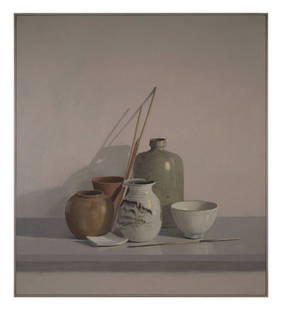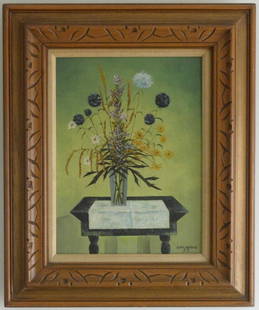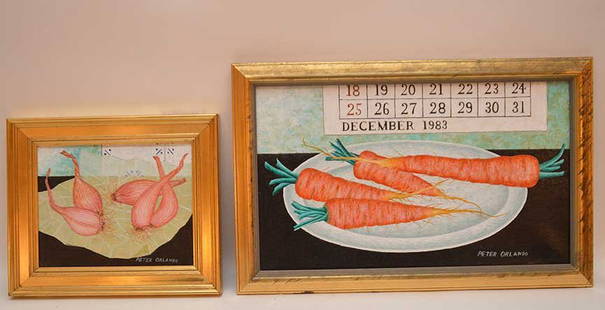
MARIANO NANI (Naples, 1725-Madrid, 1804). “Still Lifeâ€, 1762- Oil on canvas. Played on; Peter
Luis Meléndez Sale History
View Price Results for Luis MeléndezRelated Paintings
More Items in Gothic Paintings
View MoreRecommended Art
View More








Item Details
Description
MARIANO NANI (Naples, 1725-Madrid, 1804).
"Still Lifes", 1762-
Oil on canvas.
Reproduced in; Peter Cherry Luis Melendez Still-life Painter; Fundacion De Apoyo a La Historia Del Arte Hispanico, Madrid, 2006 page 256.
It has slight faults.
Measurements: 76 x 101 cm; 97 x 121 cm (frame).
Pair of still lifes formed by food and dead birds, following a similar composition centred in a clearly delimited space, limited by the wooden table on which the elements are arranged and closed at the back by a smooth wall, worked in neutral tones and darker on one of its sides, looking for the light variation and the contrast of lights and shadows. Formally, the composition is also notable for its illusionist taste, with elements protruding from the outside of the table, typical baroque trompe l'oeil. One of the most characteristic elements of the artist's mastery can be seen in the still life of the vegetable, in which a drawer on the table is half-open.
Mariano Nani was the son and pupil of Giacomo Nani, another painter, and specialised in painting still lifes. Around 1755 he began to work like his father in the royal porcelain factory in Capodimonte. He moved to Spain in 1759 in the entourage of Charles III. Settling in Madrid, he collaborated with his designs in the creation of the Royal Porcelain Factory of the Buen Retiro without abandoning still-life painting and miniatures, a technique he taught to his pupils, José de la Torre and Manuel Sorrentini. In 1764 he became a member of merit of the San Fernando Royal Academy of Fine Arts. From 1775 and through the mediation of Anton Raphael Mengs, he also provided cartoons for the Royal Tapestry Factory of Santa Bárbara. In the course of this activity he produced some of the models that were to decorate the palaces of El Pardo and Aranjuez. His style advocates hunting still lifes that are not devoid of drama, with large prey such as deer and wild boar, or small ones such as rabbits or hares. His compositions, influenced by those of the Low Countries, tend towards naturalistic representation, conveyed through a precious, soft technique and balanced tonalities. The Neapolitan still-life school of the Baroque period enjoyed a spectacular development, leaving behind the splendour of the 16th century and progressing within a clearly identifiable, fully Baroque style. Artists such as Tommaso Realfonso, Nicola Casissa, Gaspare Lopez, Giacomo Nani and Baldassare de Caro continued the local tradition by specialising in the painting of flowers, fruit, fish and game, thus satisfying the demands of a vast clientele characterised by a new 17th-century taste. In addition to these artists, there are also the minor figures who are slowly emerging from an unjust oblivion, and some artists who worked between the 17th and 18th centuries, such as Francesco della Questa, Aniello Ascione, Nicola Malinconico, Gaetano Cusati, Onofrio Loth, Elena and Nicola Maria Recco, Giuseppe Ruoppolo and Andrea Belvedere. These Neapolitan still-life painters, who worked during the 17th and early 18th centuries, are known as "i generisti" and were important not only in their own environment but also, and especially, in Spain, where the development of the genre was clearly marked by Italian influence, particularly the contribution of the Neapolitan school. Today this school is considered one of the most outstanding within the Baroque still life genre. The distinguishing feature of Neapolitan Baroque painters was always their strong naturalistic character and their warm chromaticism, with a dominance of reddish and earthy tones.
"Still Lifes", 1762-
Oil on canvas.
Reproduced in; Peter Cherry Luis Melendez Still-life Painter; Fundacion De Apoyo a La Historia Del Arte Hispanico, Madrid, 2006 page 256.
It has slight faults.
Measurements: 76 x 101 cm; 97 x 121 cm (frame).
Pair of still lifes formed by food and dead birds, following a similar composition centred in a clearly delimited space, limited by the wooden table on which the elements are arranged and closed at the back by a smooth wall, worked in neutral tones and darker on one of its sides, looking for the light variation and the contrast of lights and shadows. Formally, the composition is also notable for its illusionist taste, with elements protruding from the outside of the table, typical baroque trompe l'oeil. One of the most characteristic elements of the artist's mastery can be seen in the still life of the vegetable, in which a drawer on the table is half-open.
Mariano Nani was the son and pupil of Giacomo Nani, another painter, and specialised in painting still lifes. Around 1755 he began to work like his father in the royal porcelain factory in Capodimonte. He moved to Spain in 1759 in the entourage of Charles III. Settling in Madrid, he collaborated with his designs in the creation of the Royal Porcelain Factory of the Buen Retiro without abandoning still-life painting and miniatures, a technique he taught to his pupils, José de la Torre and Manuel Sorrentini. In 1764 he became a member of merit of the San Fernando Royal Academy of Fine Arts. From 1775 and through the mediation of Anton Raphael Mengs, he also provided cartoons for the Royal Tapestry Factory of Santa Bárbara. In the course of this activity he produced some of the models that were to decorate the palaces of El Pardo and Aranjuez. His style advocates hunting still lifes that are not devoid of drama, with large prey such as deer and wild boar, or small ones such as rabbits or hares. His compositions, influenced by those of the Low Countries, tend towards naturalistic representation, conveyed through a precious, soft technique and balanced tonalities. The Neapolitan still-life school of the Baroque period enjoyed a spectacular development, leaving behind the splendour of the 16th century and progressing within a clearly identifiable, fully Baroque style. Artists such as Tommaso Realfonso, Nicola Casissa, Gaspare Lopez, Giacomo Nani and Baldassare de Caro continued the local tradition by specialising in the painting of flowers, fruit, fish and game, thus satisfying the demands of a vast clientele characterised by a new 17th-century taste. In addition to these artists, there are also the minor figures who are slowly emerging from an unjust oblivion, and some artists who worked between the 17th and 18th centuries, such as Francesco della Questa, Aniello Ascione, Nicola Malinconico, Gaetano Cusati, Onofrio Loth, Elena and Nicola Maria Recco, Giuseppe Ruoppolo and Andrea Belvedere. These Neapolitan still-life painters, who worked during the 17th and early 18th centuries, are known as "i generisti" and were important not only in their own environment but also, and especially, in Spain, where the development of the genre was clearly marked by Italian influence, particularly the contribution of the Neapolitan school. Today this school is considered one of the most outstanding within the Baroque still life genre. The distinguishing feature of Neapolitan Baroque painters was always their strong naturalistic character and their warm chromaticism, with a dominance of reddish and earthy tones.
Buyer's Premium
- 23%
MARIANO NANI (Naples, 1725-Madrid, 1804). “Still Lifeâ€, 1762- Oil on canvas. Played on; Peter
Estimate €28,000 - €30,000
Get approved to bid.
Shipping & Pickup Options
Item located in Barcelona, -, esOffers In-House Shipping
Payment

TOP































![Peter L. ARGUIMBAU: Still Life - Oil Painting: Gilt framed oil on canvas still life with amaryllis. [Art: 24" H x 20" W; Frame: 30 3/4" H x 26 3/4" W]. In good condition.](https://p1.liveauctioneers.com/1221/319066/172112171_1_x.jpg?height=310&quality=70&version=1708541074)






























![[SEX] LOT OF 9 PHOTOGRAPHS SOLD TOGETHER: [SEX] A lot of 9 photographs sold together. Some postcards. One mounted with plastic corners in archival mat. Prints: 4.5" x 3" - 6" x 4". Generally good condition, various imperfections. *Additional](https://p1.liveauctioneers.com/8124/329546/177689790_1_x.jpg?height=310&quality=70&version=1715469494)





![Emilio Grau-Sala "Sur la Plage" Oil on Canvas: Emilio Grau-Sala (Spanish, 1911-1975), "Sur la Plage" [On The Beach], Oil on Canvas, 1958, signed "Grau Sala" lower right, signed, inscribed "Trouville", dated, and titled to verso. 21.5" H x 25.75" W](https://p1.liveauctioneers.com/5649/328023/176731071_1_x.jpg?height=310&quality=70&version=1714409606)